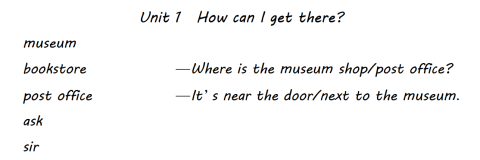人教pep六上英语 Unit 1 The first period 第一课时 教案
Unit 1 How can I get there?
![]()
教材分析 | 本单元学习的主题是问路。教学内容主要是通过吴一凡和机器人Robin去参观科学博物馆途中问路的情景来展开的。教学重点是能够听、说、读、写核心句型“—Where is the museum shop? —It’s near the door.”“—How can we get there? —Turn left at the bookstore.”;能够听、说、读、写单词和词组: science, museum, post office, bookstore, cinema, hospital, crossing, turn, left, straight, right |
教学目标 | 知识与能力目标: ·能够听、说、读、写句型“—Where is the…? —It’s near the door.”“—How can we get there? —Turn left at the bookstore.” ·能够在情景中运用句型“—Where is the…? —It’s…”询问地点并作答 ·能够在情景中运用句型“—How can we get there? —Turn left/right at the…”问路并描述路线 ·能够在图片的帮助下正确理解并按照正确的意群及语音、语调朗读有关Robin新功能的小故事,运用本单元所学核心句型讲述该故事,同时能根据阅读所获信息写出故事中的关键信息 · 能够听、说、读、写单词和词组: science museum, post office, bookstore, cinema, hospital, crossing, turn left, go straight, turn right ·能够正确使用上述单词和词组描述城市设施及其位置 ·知道英语句子有升降调,并能使用正确的语调朗读不同类型的句子 情感态度、文化意识、学习策略目标: ·能够在迷路时主动寻求帮助 ·能够适度饮食,不暴饮暴食 ·了解英国代表性建筑“伦敦眼”,著名河流泰晤士河以及特色快餐“Fish and chips” ·能够通过看图捕捉主要信息,并根据提示做出听前预测 ·能够通读文段,获取主旨大意,通过相关细节猜测词义 |
课时安排 | 第一课时: Part A Let’s try & Let’s talk 第二课时: Part A Let’s learn & Make a map and talk 第三课时: Part B Let’s try & Let’s talk 第四课时: Part B Let’s learn & Be a tour guide 第五课时: Part B Read and write 第六课时: Part B Let’s check & Let’s wrap it up |
The first period(第一课时)
Part A Let’ s try & Let’s talk ![]()
▶教学内容与目标
课时教学内容 | 课时教学目标 |
Let’s try | ·能够读懂题目要求,对听力的重点内容进行预测 ·通过听录音,运用基本的听力技巧,勾选正确的选项 |
Let’s talk | ·通过观察、谈论Let’s talk板块的图片,在PPT和老师的帮助下理解对话大意,并能够回答对话下面的问题 ·通过听录音,能够用正确的意群及语音、语调朗读对话,并能在小组中进行角色表演 ·能够在情景中恰当运用句型“—Where is the…? —It’s…”询问地点并作答 ·能够在语境中借助图片等帮助理解新词“museum, bookstore, post office, ask, sir”的意思,并能够正确发音 ·能够运用礼貌用语寻求他人的帮助 |
▶教学重点
能够理解和掌握本课时的重点词汇和句型。
▶教学难点
能够在情景中恰当运用句型“—Where is the…? —It’s…”询问地点并作答。
▶教学准备
PPT课件、课文录音、视频等。
 ▶教学过程
▶教学过程
1
Step 1: Warm-up & Lead-in
1. Greetings.
Greet students. Divide them into several groups. The group which gets the most points will be the winner.
2. Quick review.
Review the words and the phrases of the locations “in front of, near, next to, behind, between” with the pictures. (课件出示: 表示方位介词的图片)
3. Read and guess.
Read the sentences and guess what places they are.


 4. Lead-in.
4. Lead-in.
Present the main scene on page 2.(课件出示: Unit 1主情景图)
T: What can you see in the main scene?
Ss: We can see a hospital, a park, a restaurant…
T: Here are Wu Binbin and Robin. Wu Binbin likes robots very much. Where can Wu Binbin go?
Ss: He can go to the science museum.
T: Where is the science museum? How can he get there? Today we’ll learn “Unit 1 How can I get there?”
Write down the title of “Unit 1” on the blackboard.
Step 2: Presentation
 1. Let’s try.
1. Let’s try.
(1)Freely talk about robots.
In a science museum, we can see many interesting things of hightech. Present some pictures of hightech robots on exhibition. (课件出示: 能做各种不同动作的机器人的图片及相应的动词词组)
T: These robots are so cool! What can they do?
Ss: They can…
(2)Listen and tick.
Ask students to read “Let’s try” and predict the content of listening and the answers to the questions. Then students listen and tick the right options for the questions. At last, check the answers together. (课件出示: 教材P4 Let’s try板块的习题、音频及答案)
(3)Read the listening materials.
Learn the key sentences underlined. (课件出示: 教材P4 Let’s try板块的听力材料)
2. Watch and answer.
Wu Binbin and Robin are at the science museum now. Wu Binbin has something to do. Watch the video of “Let’s talk” and answer the questions. Lead students to get the main idea of the dialogue. (课件出示: 教材P4 Let’s talk板块的对话视频和问题)
Q: What does Wu Binbin want to do? (He wants to buy a postcard and send it.)
Compare the differences between “buy” and “send” with pictures. (课件出示: 买明信片和寄明信片的图片)
 3. Get more details.
3. Get more details.
Watch the video of “Let’s talk”again and answer the following questions. (课件出示: 问题①②,配图museum shop和post office)
①Where can Wu Binbin buy the postcard? Where is the museum shop?
②Where can he send the postcard? Where is the post office?
Highlight the sentence structure “Where is…?” Make brief talks with students while checking the answers. (课件出示: 问题①②的答案)
Write down “museum shop, post office” and the sentence structure “Where is…?” on the blackboard.
①Key: He can buy the postcard in the museum shop. The museum shop is near the door.
T: What else can you buy in a museum shop?
Ss: I can also buy some toy robots/soft toys/toy machines/books…
②Key: He can send the postcard in the post office. The post office is next to the museum.
T: Does Robin know where the post office is?
Ss: No, he doesn’t.
T: So how can they find the post office?
Ss: They can use a map./They can ask other people.
T: Yes. If you need help, just try to be brave and ask for help.
Learn the key words “ask, sir” in detail. (课件出示: ask和sir的相关内容)
Write down “ask, sir” on the blackboard.
T: Robin asks a man where the post office is. The man is so surprised that Robin can talk. It is a talking robot. He thinks the museum is a great museum. (Simply explain “a talking robot” and “What a great museum!”)
T: Where is the post office?
 Ss: It’s next to the museum. (课件出示: 对比near和next to的区别)
Ss: It’s next to the museum. (课件出示: 对比near和next to的区别)
Step 3: Practice
1. Read and act.
(1)Students read after the recording. Pay attention to the pronunciation and the intonation.
(2)Let students practice the dialogue in roles in groups.
(3)Act out.
2. Draw a map for the museum.
 Students read the dialogue and try to draw a simple map for the museum. Work in pairs to make a brief introduction of their maps. Then choose two students to come to the front to share their maps. They can say like this:
Students read the dialogue and try to draw a simple map for the museum. Work in pairs to make a brief introduction of their maps. Then choose two students to come to the front to share their maps. They can say like this:
The museum shop is… You can…there.
The post office is… You can…there.
Step 4: Consolidation & Extension
- Create a new dialogue.
T: If you are Wu Binbin, what gift do you want to buy? You can be in a supermarket or anywhere you want to be. Create a new dialogue and let’s find out more ideas. You can do it like this:
 Wu Binbin: Robin, where is the…? I want to buy…
Wu Binbin: Robin, where is the…? I want to buy…
Robin: It’s…
Wu Binbin: Thanks. Where is the…? I want to…today.
Robin: I don’t know. I’ll ask. Excuse me, sir.
Man: Wow! A talking robot! That’s interesting!
Robin: Where is the…?
Man: It’s…
 Robin: Thanks.
Robin: Thanks.
The teacher makes a model with two students first. Then ask students to work in groups. Choose one or two groups to act out.
- Talk about your city.
T: Now we’ve known something about Wu Binbin’s city. Can you talk about something about your city/town/village?
The teacher sets a model and makes a brief conversation with a student first. You can use these words: park, library, zoo, post office, school, museum… (课件出示: 对话练习的框架)
 Then students work in groups and talk about the places in their city/town/village.
Then students work in groups and talk about the places in their city/town/village.
- Make a summary.
Lead students to make a summary of this class. Let them conclude the key words and sentence structures they’ve learned. Encourage students to be brave and ask for help if they need.
1
▶板书设计

▶作业设计
- Practice the dialogue.
- Write down your new dialogue.
▶教学反思
1. 热身环节快速复习方位介词以及有关建筑物和场所的词汇,为下面即将要学习的对话做好词汇铺垫。通过主情境图创设情境,为即将学习的Let’s try板块设置话题背景。
2. 呈现活动由浅入深,注重培养学生听前预测的习惯。以学生为本,引导和启发学生思考,注重对学生思维能力的培养。
3. 基于课本基础,设置多元化的教学活动,适当拓展,丰富学生表达,提高其语言综合运用能力。
4. 板书设计清晰明了,重点突出,起到了很好的辅助作用。
![]()
▶Teaching Contents & Teaching Aims
Let’s try
·Be able to predict the main content of the listening part by reading the questions.
·Be able to understand the recording and tick the right answers.
Let’s talk
·Be able to understand the main idea of the dialogue by observing the pictures and answer the questions below the dialogue.
·Be able to read the dialogue correctly, fluently and emotionally, and then act out in groups.
· Be able to listen, speak, read, write and use the sentence structures “—Where is the…?—It’s…” properly to ask and answer about the locations in scenes.
·Be able to have a good command of the new words “museum, bookstore, post office, ask, sir”.
·Be able to learn to ask for help politely.
▶Teaching Priorities
·Be able to understand and master the key words and sentence structures of this lesson.
▶Teaching Difficulties
·Be able to use the sentence structures “—Where is the…? —It’s…” properly to ask and answer about the locations in scenes.
▶Teaching Procedures
Teaching Stages | Teacher’ s Activities | Students Activities | Teaching Purposes |
Warm-up & Lead-in | 1. Greetings. 2. Quick review. 3. Read and guess. 4. Lead-in. Present the main scene on page 2 on the PPT. | 1. Greet the teacher and understand the mode of evaluation. 2. Review the words of locations. 3. Read and guess what places they are. 4. Talk about the main scene on page 2. | Review the words and the phrases of prepositions and buildings through the guessing game. Get students prepared for the following learning, and set a topic background for the dialogue. |
Presentation | 1. Let’s try. (1)Present pictures and talk with students. (2)Ask students to listen and tick. (3)Present the listening materials and teach the key sentences. | (1)Freely talk about robots. (2)Listen and tick. (3)Read the listening materials. | Stimulate students’ interest in learning and attract their attention through a variety of robots with different functions. Cultivate students’ habit of making predictions before listening. |
2. Watch and answer. Play the video of “Let’s talk” and ask the questions. Lead students to get the main idea of the dialogue. | Watch the video of “Let’s talk” and answer the questions. Get the main idea of the dialogue. | Lead students to get a whole perception of the dialogue and the main idea of it with questions. | |
3. Get more details. Play the video of “Let’s talk” again and ask students to answer the questions. Teach “museum, shop, post office” and “—Where is…? —It’s…” Talk with students and teach the words “ask, sir” in detail. “It’s time for…” Teach the sentence “Time to go home.” and the word “kid”. Contrast “It’s time for…” with “It’s time to…” | Watch the video of “Let’s talk” again and answer the questions. Learn “museum, shop, post office” and“—Where is…? —It’s…” Talk with the teacher about more details. Learn the words “ask, sir” in detail. Understand the sentence “Time to go home.” and the word “kid”. Learn the difference between “It’s time for…”and “It’s time to…” | Make corresponding extension based on the context to improve students’ pragmatic ability. Penetrate the emotional aim. Lead students to ask for help from others when they encounter difficulties. |
(续表)
Teaching Stages | Teacher’ s Activities | Students’ Activities | Teaching Purposes |
Practice
| 1. Read and act. | (1)Read after the recording. Pay attention to the pronunciation and the intonation. (2)Practice in roles in groups. (3)Act out. | Lead students to read the dialogue in correct pronunciation and intonation and act it out in groups to practice the dialogue. |
2. Draw a map for the museum.
| Read the dialogue and try to draw a simple map for the museum. Work in pairs and make a brief introduction of the maps. | Help students go deeper into the text. Lead students to describe the locations, as well as activities that can be carried out there. Enrich students’ expression. | |
Consolidation & Extension | 1. Create a new dialogue. | Work in groups. Create a new dialogue and find out more ideas. | Lead students to reconstruct the text. Consolidate the key words and sentence structures by creating new dialogues. |
2. Talk about your city. Set a model and make a brief conversation with a student first. | Talk about the places in their city/town/village. | Extend students’ expression of their preferences and frequent activities. Improve their comprehensive language using ability. | |
3. Make a summary. | Conclude the key words and sentence structures they’ve learned. | Get an overview of the class and penetrate the emotional goal. | |
Homework |
| ||
1
